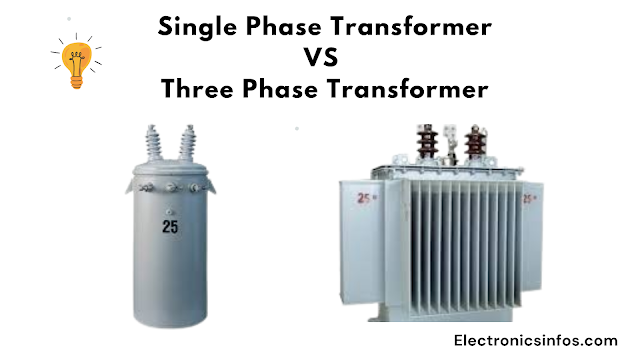Electrical Power Transformer
A transformer is an electrical device that steps up and down the voltages. The transformer works on the principle of electromagnetic induction. There are two types of winding in a single-phase Transformer: primary winding and secondary winding.
The winding connected to the input supply is called primary, and the winding connected to the load side is called secondary winding.
The primary winding produces an alternating magnetic field and links the secondary winding to induce the EMF. The frequency is not changed in the transformer during the operation. There are Three sets of winding in a Three-phase Transformer.
There are two types of transformers for their supply voltages including
- Single Phase Transformer
- Three Phase Transformer
In this article, We Compare the Single-phase and three-phase transformers in detail
Single-phase Transformer
- There are two windings used in a Single-phase transformer.
- The voltage level of a single-phase transformer is 230v.
- No Cooling system is required in a single-phase Transformer.
- the single-phase transformer used for lightning Load.
- The power transfer capability of a single-phase transformer is less compared to the three-phase transformer.
- In a single-phase transformer, we use a single-phase conductor.
- To complete the circuit we require two wires one is a phase and another is neutral.
- In a single-phase transformer, only one sine wave is generated.
- The angle between voltage and current in a single-phase transformer is 90 degrees.
- The Design of a single-phase transformer is simple.
- The laminated core is used in a single-phase transformer.
- we need three single-phase transformers to obtain a three-phase transformer.
- It occupied less space than the three-phase transformer.
- It required more maintenance.
- The initial cost is high up to 15% to obtain a Three-phase using a Single-phase transformer.
- its efficiency is lower if used 3 single-phase transformers obtain three-phase
- It requires more space if we use 3 single-phase transformers to obtain a three-phase transformer.
- it provides a backup. if one unit is faulty the other provides the supply in the case of three units.
- The supply frequency is 50Hz.
- Single-phase machines are less efficient.
Three-phase Transformer
- There are Three windings in a Three-phase transformer.
- Three-phase transformer the voltage level is 415v.
- The power transfer capability of a Three-phase transformer is more.
- We need a cooling System with a Three-phase Transformer.
- A phase transformer is used for high power load.
- The Design of a three-phase transformer is complex.
- There are 4 types of winding connections in three-phase transformers.
- The winding connection is Star-Star, Delta-Delta, Star-Delta, and Delta-Star.
- In a Three-phase transformer, we use 3 phase conductors.
- To complete the circuit we require 3 wires or 4 wires in the case of delta and star respectively
- In a Three-phase transformer, three sine waves are generated.
- The angle between voltage and current in a Three-phase transformer is 120 degrees.
- The Design of a Three-phase transformer is Complex.
- The Three laminated core is used in a Three-phase transformer.
- To obtain a three-phase we used a single three-phase unit.
- Three-phase is used in the distribution, heavy industries, transmission systems, etc.
- It occupied less space in the case of three-phase power.
- It required Less maintenance because of a single unit.
- The initial cost is Low up to 15% in the case of a single-phase 3 transformer.
- The efficiency of a three-phase transformer is High.
- It requires less space because of a single-unit transformer.
- It does not provide a backup Because it's a single unit.
- the supply frequency is 50Hz.
- Three-phase machines are more efficient.


.png)

-Electronicsinfos.png)

0 Comments
please do not insert spam links